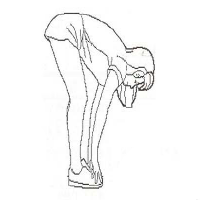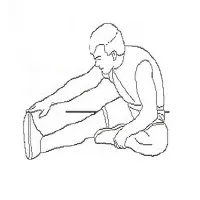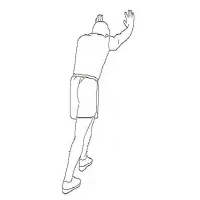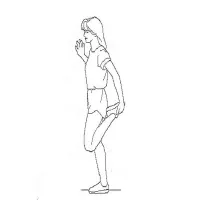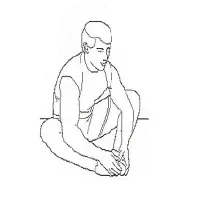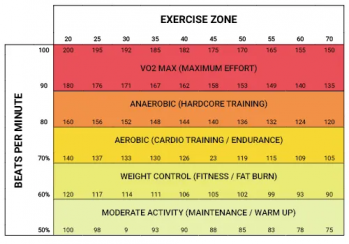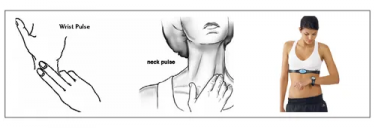
All fitness objectives need a plan and a helping hand; at Elite Fitness we are here to help you get the most from your training.
An awesome alternative to running without the impact on the joints, Ellipticals offer a great cardio workout. Whether you are a beginner wanting to get back in shape, or regular exerciser we have designed 2 customisable workouts that allow you to get the most out of your elliptical machine!
We have devised these programmes to not only fast-track your fitness but to make it more interesting along the way.
Read on to find out the benefits of and correct use of an elliptical machine training, or jump straight to the workouts here.
What Is Elliptical Training Good For?
Elliptical workouts are a great way to get your heart rate up and burn calories through aerobic exercise. It’s also low-impact, so it’s easy on the joints as your feet are in contact with the machine for the entire workout. Elliptical trainers can be used for a variety of workouts, from beginner to advanced.
If you’re new to an elliptical machine, start with our beginner elliptical workout. This will help you get used to the motion and build up your endurance. Once you’re comfortable, you can move on to more advanced workouts.
How Long Should You Workout on an Elliptical?
This depends on your individual fitness goals. However, as a general guideline, you should aim to train for at least 30 minutes per session. If you’re new to working out, start with shorter sessions and gradually increase the time as you get more comfortable.
One great thing about elliptical cross trainers is that you can easily adjust the intensity to suit your needs. If you’re looking for a more challenging workout, you can increase the resistance or incline on the machine. Conversely, if you need a less intense workout, you can lower the settings.
Finally, be sure to warm up before beginning your elliptical trainer workout and cool down afterwards. This will help minimise the risk of injury and make your workout more effective.
Are Ellipticals Good for Losing Weight?
An elliptical machine can be a great tool for weight loss. Because they can provide both aerobic and resistance training, ellipticals help to burn calories and build muscle. This makes them ideal for people who are looking to lose weight or tone up.
In general, the more intense your workout is, the more calories you’ll burn. So Yes, ellipticals can be very effective for losing weight. Because they provide a low-impact workout, they are easy on the joints and muscles. Additionally, ellipticals provide a full-body workout, which helps to burn more calories.
Correct Elliptical Technique
It’s important to use the elliptical trainer correctly in order to avoid injury and get the most out of your workout. Here are a few tips:
– Stand up straight and tall with your shoulders back and down.
– Keep your hands on the handles, but don’t grip them too tightly.
– Use your whole foot when pedalling and don’t let your heels come off the pedals.
– Keep your core engaged
– Keep a smooth and even pace throughout your workout.
By following these tips, you’ll be sure to get a great workout on your elliptical trainer.
SAFETY FIRST
- If you experience dizziness, nausea, chest pain, or any other abnormal symptoms, STOP the workout at once. CONSULT A PHYSICIAN IMMEDIATELY.
- No matter if you are an elite athlete or a weekend warrior, it is essential to drink enough water before, during and after exercise. Dehydration will stop you from getting the most out of your workout and feeling tip-top!
- Before using the machine to exercise, always do stretching exercises to properly warm up.
- Always wear appropriate workout clothing when exercising. Dress accordingly to the temperature and do not wear loose clothing that could become caught in the machine. Sporting shoes are recommended when using the treadmill.
- Use the machine only for its intended use
- Keep children and pets away from the machine at all time. DO NOT leave children unattended in the same room with the machine.
- Disabled persons should not use the machine without a qualified person or physician in attendance.
- Only one person at a time should use the machine.
- Inspect and tighten all the loose parts before this equipment is used.
- Keeps hands away from moving parts.
- Position the machine on a clear, levelled surface. DO NOT use the machine near water or outdoors.
- Inspect the machine before each use; make sure all of the connections are tightly secured.
- Do not place any sharp object around the machine.
- And lastly, ensure that you know how to operate your machine – check that your speed, incline and emergency stop is functional. Never operate the machine if the machine is not functioning properly.
Now let’s get to it!
The Workouts
Elliptical Workout Plan for Beginners
If you’re just starting out on an elliptical trainer, it’s important to ease into your workout routine. Our 20 minute workout plan for beginners is the perfect way to get started.
Start by warming up for 5-10 minutes at a low intensity. Then, increase the intensity for 2-3 minutes before returning to a lower intensity for 1-2 minutes. Repeat this cycle for a total of 20-30 minutes.
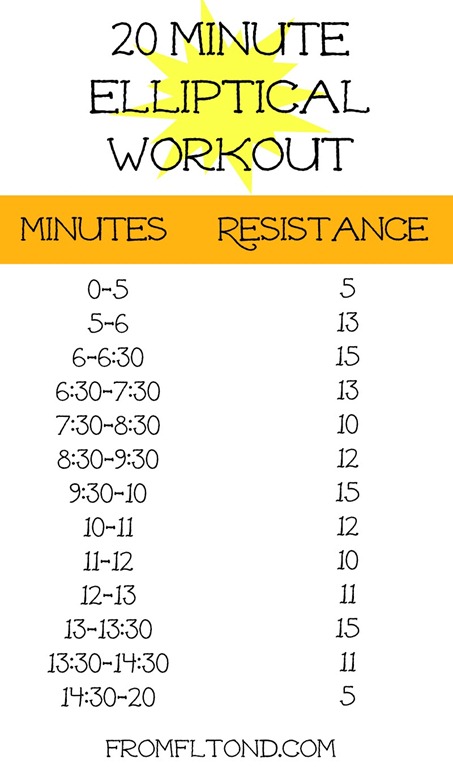
Elliptical Workout Plan for Intermediate to Advanced Users
If you’re already comfortable with your elliptical machine, you can start to increase the intensity and duration of your workouts. Interval training is also a great way to challenge yourself and continue seeing results.
Start by warming up for 5-10 minutes at a moderate intensity. Then, increase the intensity for 1-2 minutes before returning to a lower intensity for 30 seconds. Repeat this cycle for a total of 20-30 minutes.
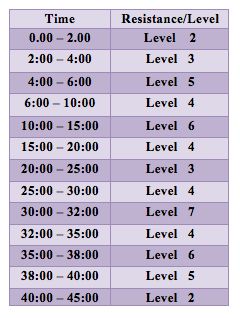
Workout Variations
As you become more comfortable with this workout, you can increase the duration and number of intervals. You can also add hills or other challenges to your routine to keep things interesting.
If you’re looking for a challenge, start by warming up for 5-10 minutes at a moderate intensity. Then, increase the intensity for 2-3 minutes before returning to a lower intensity for 1 minute. Repeat this cycle for a total of 20-30 minutes.
As you become more comfortable with this workout, you can increase the duration and number of intervals. You can also add hills or other challenges to your routine to keep things interesting.
These two exercises are to help you work up a sweat, no matter what your level of fitness is.
There are a number of ways to mix up your elliptical workout to change the motion pattern. Instead of pedalling in a forward motion, you can try reverse pedalling or using an elliptical with movable arms. This will help target different muscle groups and keep your workout interesting.
PRO TIP: Mixing in a bit of strength by training with and without handles in these cardio elliptical workouts. Using the machine with moving handles targets your upper body – pushing the handles works your chest while pulling works your back. Skipping handles altogether works the core and lower body. Peddling in both directions targets quads and hamstrings, making them sing post workout!
Target Heart Rate
| Cardiovascular Training plays an important part in maintaining a healthy heart and lung function, so it’s no surprise we should be paying attention to how quickly our heart beats during exercise. There are different heart rate training zones determined by the individual’s age and workout goals to ensure you train safely and effectively.
Before starting any workout regimen, it’s important to know what your target heart rate should be. Different types of workouts are performed at different intensities, or workout zones. Target heart rates are a percentage of your theoretical maximum heart rate and can help ensure that you’re neither working too hard nor not hard enough. By working out your theoretical maximum heart rate, you can figure out the target ranges and zones for different types of workouts. How to Calculate Your Maximum Heart Rate.A very simple method to find out your target heart rate, take your age and subtract it from 220. That number will be your maximum heart rate. From there, you can use the following formulas to calculate your target heart rate: 220 – AGE = TMHR (Theoretical Maximum Heart Rate in beats per minute) TMHR x 85% = (Upper Training Limit) bpm (Beats per Minute) TMHR x 65% = (Lower Training Limit) bpm Example: If you’re 39 years old, your max heart rate would be: 220 – 39 = 181 bpm 85% of this would be the upper limit for most workouts, while 65% would be the lower limit: 181 x 85% (0.85) = 154 bpm and 181 x 65% (0.65) = 118 bpm
Remember, these are just guidelines. You may need to adjust based on how you’re feeling during your workout. If you’re working at a moderate intensity but don’t feel like you’re breaking a sweat, you may need to bump up the intensity. Similarly, if you’re working at a vigorous intensity but feel like you’re about to collapse, you may need to back off a bit. How to measure your heart rate during exerciseYour heart rate can be measured by using the radial (wrist) or carotid (neck) pulse using your index and middle fingers, counting the beats for 10 seconds and multiplying by 6.
Many sports watches will incorporate a heart rate monitor that utilises an optical sensor to calculate your heart rate from blood flow. Accuracy will vary by device and conditions but can give you a good estimate. Chest heart rate straps will give you the most accurate reading, as these measure the electrical signals from your heart. Cardiovascular Training plays an important part in maintaining a healthy heart and lung function, so it’s no surprise we should be paying attention to how quickly our heart beats during exercise. The chart below outlines a range of heart rate training zones determined by the individual’s age and workout goals to ensure you train safely and effectively.
Written by Elite Fitness Team, |
